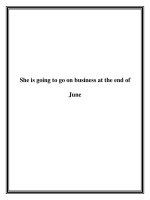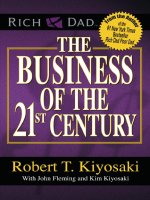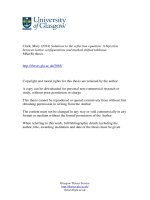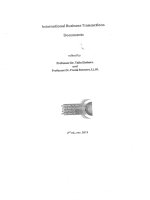Business Transactions & the Accounting Equation
Bạn đang xem bản rút gọn của tài liệu. Xem và tải ngay bản đầy đủ của tài liệu tại đây (105.7 KB, 29 trang )
BUSINESS TRANSACTIONS &
THE ACCOUNTING EQUATION
12/06/16
Chapter 3
1
PROPERTY & FINANCIAL CLAIMS
Property – anything of value that a person or business owns
& therefore controls.
Financial claim – legal right to the item.
Credit – when you buy something and agree to pay for it
later.
Why is it dangerous to make minimum payments on credit card
balances?
Creditor – the business or person selling you the item on
credit
12/06/16
2
FINANCIAL CLAIMS IN ACCOUNTING
• Assets – property or items of value owned by a business
– Cash
– Office equipment
– Manufacturing equipment
– Buildings
– Land
• Equities – financial claims to these assets
• Owner’s equity – dollar amount of the owner’s claims to the total assets of
the business
• Liabilities – debts of the business
• Accounting equation (Assets = Liabilities + Owner’s Equity)
12/06/16
3
TRANSACTIONS THAT AFFECT OWNER’S
INVESTMENT CASH, & CREDIT (3.2)
• Business transaction
– Accounts receivable (2nd asset account)
– Total amount of money owed to a business – money to be received later because of
the sale of goods or services on credit.
– This account is an asset because it represents a claim to the assets of other people
or businesses.
– It represents a future value that eventually will bring cash into the business.
– When the business receives payment, it cancels the claim.
– Accounts payable
– Amount owed, or payable, to the creditors of a business.
12/06/16
4
EFFECTS OF TRANSACTIONS ON THE
ACCOUNTING EQUATION
– When a business transaction occurs, an accounting clerk analyzes the
transaction to see how it affects each part of the accounting equation
– Follow these steps:
1.
2.
3.
4.
Identify the accounts listed
Classify the accounts listed
Determine the amount of increase or decrease for each account affected
Make sure the accounting equation remains in balance
Most businesses have the following types of transactions:
Investments by the owner
Credit transactions
Revenue & expense transactions
Withdrawals by the owner
12/06/16
5
INVESTMENTS BY THE OWNER
– Money or other property paid out in order to produce profit
– Business Transaction 1
– Maria Sanchez took $25,000 from personal savings and deposited that amount to open a
business checking account in the name of Roadrunner Delivery Service.
– Analysis
1. Cash transactions are recorded in the account Cash in Bank. Maria Sanchez is investing
personal funds in the business. Her investment in the business is recorded in the account
called Maria Sanchez, Capital.
2.Cash in Bank is an asset account. Maria Sanchez, Capital is an owner’s equity account
3.Cash in Bank is increased by $25,000. Maria Sanchez, Capital is increased by $25,000
as well
4. The accounting equation remains in balance.
Assets = Liabilities + Owner’s Equity
$25,000 = 0 + $25,000
12/06/16
6
BUSINESS TRANSACTION 2
Maria Sanchez transferred two telephones valued at $200 each from her
home to the business.
Why are phones considered an investment?
Analysis
1.Maria Sanchez gave two telephones to the business. This affects the
account Office Equipment. The investments of these assets affects
the account Maria Sanchez, Capital .
2.Office equipment is an asset account. Maria Sanchez, Capital is
an owner’s equity account.
3.Office equipment is increased by $400. Maria Sanchez, capital is
increased by $400.
4.The accounting equation remains in balance.
12/06/16
7
Assets
Prev. Bal
Cash in Bank
Office
Equipment
$25,000
0
Trans. 2
Balance
12/06/16
= Liabilities
Maria
Sanchez,
Capital
0
+ $400
$25,000
+ $400
+ Owner’s
Equity
$25,000
+ $400
=0
+ $25,400
8
CASH PAYMENT TRANSACTIONS
– Transaction 3 is the cash purchase of an asset.
– Any asset purchased for cash is recorded this way, but the account name
of the asset purchased may vary
– Transaction 3 affects only the assets side of the equation.
– Roadrunner exchanged one asset (cash) for another asset (computer
equipment)
12/06/16
9
ANALYSIS
Identify
1. Transactions involving any type of computer equipment are recorded in the
Computer Equipment account. The business paid cash for the computer
system, so the account Cash in Bank is affected. Check payments are
treated as cash payments and are recorded in Cash in Bank
2.Computer equipment and Cash in Bank are both asset accounts
3.Computer equipment is increased by $3,000. Cash in Bank is
decreased by $3,000
4. The accounting equation remains in balance.
12/06/16
10
BUSINESS TRANSACTION 3
Assets
Cash in
Bank
Computer
Equipment
Prev. Bal.
$25,000
Trans. 3
-3,000
+ 3,000
Balance
$22,000
+ 3,000
12/06/16
=
Liabilities
Office
Equipment
+ Owner’s
Equity
Maria
Sanchez,
Capital
$400
0
$25,400
+ 400
=0
+ $25,400
11
CREDIT TRANSACTIONS (ON ACCOUNT)
Now you’ve learned about cash transactions, let’s look at how the use of
credit affects the accounting equation.
When a business buys an item on credit, it is buying on account.
Business Transaction 4 – Roadrunner bought a used truck on account
from North Shore Auto for $12,000
12/06/16
12
ANALYSIS
1. Roadrunner purchased a truck to be used as a delivery vehicle, so the
account Delivery Equipment is affected. The business promised to
pay for the truck at a later time. The promise to pay is a liability;
therefore, the Accounts Payable account is affected.
2. Delivery equipment is an asset account. Accounts Payable is a
liability account.
3. Delivery account is increased by $12,000. Accounts Payable is
also increased by $12,000.
4. The accounting equation remains in balance.
12/06/16
13
Assets
Prev. Bal.
12/06/16
+
Owner’s
Equity
Cash in
Bank
Computer
Equip.
Office
Equip.
Delivery
Equip.
Accounts
Payable
Maria
Sanchez,
Capital
$22,000
$3,000
$400
0
0
$25,400
Trans. 4
Balance
=
Liabilitie
s
+ $12,000 + $12,000
$22,000
$3,000
$400
$12,000
= $12,000
$25,400
14
BUSINESS TRANSACTION 5
Roadrunner sold one telephone to Green Company for $200 on account
Analysis
1. Since Roadrunner has agreed to receive payment for the telephone at a later time,
the Accounts Receivable account is affected. The business sold the telephone, so
the account Office Equipment is also affected.
2. Both Accounts receivable and Office Equipment are asset accounts.
3. Accounts Receivable is increased by $200. Office equipment is decreased by
$200.
4. The accounting equation remains in balance.
12/06/16
15
Assets
Prev.
Bal.
Cash in
Bank
Accounts
$22,000
0
Trans. 5
Balance $22,000
12/06/16
Computer
Receivable
Equip.
$3,000
$200
+ $200
= Liab
+ OE
Accounts
Maria
Office
Equip.
Delivery
Equip.
$400
$12,000 $12,000 $25,400
Payable Sanchez,
Capital
- 200
+ $3,000
+ $200
+ $12,000
= $12,000
+ $25,400
16
BUSINESS TRANSACTION 6
Roadrunner issued a check for $350 in partial payment of the amount owed
to its creditor, North Shore Auto
Analysis
1. The payment decreased the total amount owed to the creditor, so
Accounts Payable is affected. Payment was made by check, so the
account Cash in Bank is affected.
2.Accounts Payable is a liability account. Cash in Bank is an asset
account.
3.Accounts Payable is decreased by $350. Cash in Bank is also
decreased by $350
4. The accounting equation remains in balance.
12/06/16
17
Assets
Cash in
Bank
AR
Comp
Equip
Off
Equip
Delivery
Equip
= Liab
+ OE
AP
Maria
Sanchez,
Capital
Prev.
Bal.
$22,000
Trans. 6
-350
Balance $21,650
12/06/16
$200
$3,000
$200
$12,000 $12,000 $25,400
-350
+ $200
+ $3,000
+ $200
+ $12,000
= $11,650
+ $25,400
18
BUSINESS TRANSACTION 7
Roadrunner received & deposited a check for $200 from Green Co. the
check received is full payment for the telephone sold on account in
Transaction 5.
Analysis
1. The check decreases the amount owed to Roadrunner, so Accounts
Receivable is affected. A check is given as payment, so Cash in Bank is
affected.
2.Accounts Receivable and Cash in Bank are asset accounts.
3.Accounts Receivable is decreased by $200. Cash in Bank is increased
by $200.
4. The accounting equation remains in balance.
12/06/16
19
Assets
Cash in
Bank
AR
Prev.
Bal.
$21,650
$200
Trans. 7
+200
-200
Balance $21,850
12/06/16
+ $0
= Liab
+ OE
AP
Maria
Comp
Equip
Office
Equip
Delivery
Equip
$3,000
$200
$12,000 $11,650 $25,400
+ $3,000
+ $200
+ $12,000
Sanchez,
Capital
= $11,650
+ $25,400
20
TRANSACTIONS THAT AFFECT REVENUE,
EXPENSE, & WITHDRAWALS BY THE OWNER
(3.3)
Revenue – income earned from the sale of goods or services
Fees earned for services performed
Cash received from the sale of merchandise
Revenue increases owner’s equity because it increases the assets of the
business
Both revenue & investments by the owner increase owner’s equity but they
represent very different transactions
Revenue is income from the sale of goods & services
Investment by the owner is the dollar amount contributed to the business by
the owner
12/06/16
21
EXPENSE
To generate revenue, most businesses must also incur expenses to buy
goods, materials, and services
Expense – cost of products or services used to operate a business
Ex. Rent, utilities, & advertising
Expenses decrease owner’s equity because the decrease the assets of the
business or increase liabilities
Summary:
Revenue increases assets & increases owner’s equity
Expenses decrease assets and decrease owner’s equity or increase liabilities and
decrease owner’s equity
12/06/16
22
BUSINESS TRANSACTION 8
Roadrunner received a check for $1,200 from a customer, Sims
Corporation, for delivery services.
Analysis
1. Roadrunner received cash, so Cash in Bank is affected. The payment
received is revenue. Revenue increases owner’s equity, so Maria Sanchez,
Capital is also affected.
2.Cash in Bank is an asset account. Maria Sanchez, Capital is an
owner’s equity account.
3.Cash in Bank is increases by $1,200. Maria Sanchez, Capital is also
increases by $1,200
4. The accounting equation remains in balance
12/06/16
23
Assets
Cash in
Bank
AR
Comp
Equip
Off
Equip
Prev.
Bal.
$21,850
$0
$3,000
$200
Trans. 8
+ 1,200
Balance $23,050
12/06/16
Deliv
Equip
= Liab.
+ OE
AP
Maria
Sanchez,
Capital
$12,000 $11,650 $25,400
+1,200
+ $0
+ $3,000
+ $200
+ $12,000
= $11,650
+ $26,600
24
BUSINESS TRANSACTION 9
Roadrunner wrote a check for $700 to pay the rent for the month.
Analysis:
1.Roadrunner pays rent for use of building space. Rent is an expense.
Expenses decreases owner’s equity, so the account Maria Sanchez,
Capital is affected. The business is paying cash for the use of the
building, so Cash in Bank is affected.
2.Maria Sanchez, Capital is an owner’s equity account. Cash in
Bank is an asset account.
3.Maria Sanchez, Capital is decreased by $700. Cash in Bank is
decreased by $700
4.The accounting equation remains in balance
12/06/16
25









